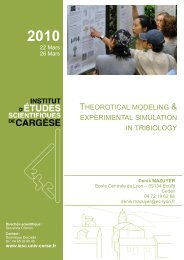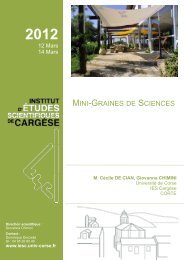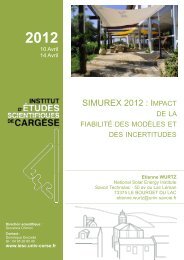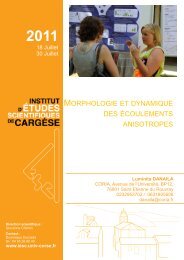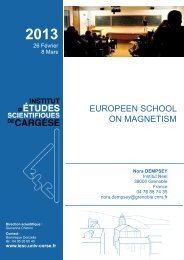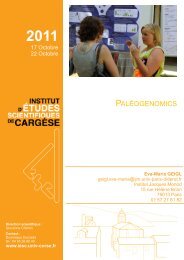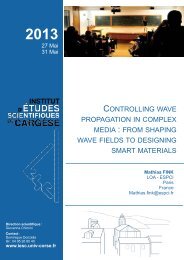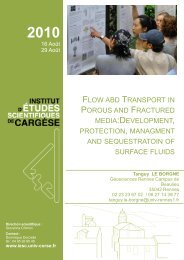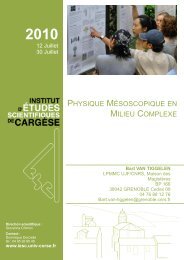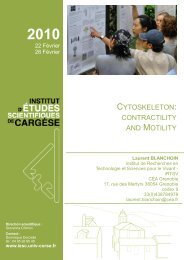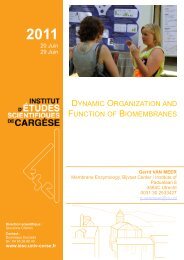nanoelectronics - Institut d'Études Scientifiques de Cargèse (IESC)
nanoelectronics - Institut d'Études Scientifiques de Cargèse (IESC)
nanoelectronics - Institut d'Études Scientifiques de Cargèse (IESC)
Create successful ePaper yourself
Turn your PDF publications into a flip-book with our unique Google optimized e-Paper software.
Monday<br />
Abstracts<br />
Monday, October 22<br />
Introduction to a few basic concepts in thermoelectricity<br />
Giuliano Benenti<br />
Center for Nonlinear and Complex Systems, Università <strong>de</strong>gli Studi <strong>de</strong>ll'Insubria, Via Valleggio<br />
11, 22100 Como, Italy<br />
I will review fundamental aspects of heat to work conversion, including the phenomenological<br />
coupled charge and heat transport equations of non-equilibrium thermodynamics, the<br />
Onsager reciprocity relations, the figure of merit ZT for thermoelectric efficiency, the<br />
Curzhon-Ahlborn efficiency at maximum power, the Wie<strong>de</strong>mann-Franz law and Mott's<br />
formula.<br />
__________________________________________________________________________<br />
Thermal Transport and Thermoelectric Coefficients Near the An<strong>de</strong>rson Transition and<br />
in 3-Terminal Molecular-Type Junctions (*)<br />
Yoseph Imry<br />
Weizmann <strong>Institut</strong>e of Science<br />
(*) Patent application pending<br />
We start by reviewing thermal and thermoelectric linear transport, including the various<br />
coefficients the symmetry relations among them (Onsager) and what <strong>de</strong>termines their<br />
magnitu<strong>de</strong>s. Applications will be briefly mentioned along with the requirements on the above<br />
coefficients.<br />
Next, the An<strong>de</strong>rson localization transition will be consi<strong>de</strong>red at finite temperatures. This<br />
inclu<strong>de</strong>s the electrical conductivity as well as the electronic thermal conductivity and the<br />
thermoelectric coefficients [1-3]. The latter becomes relatively large at low temperatures near<br />
the transition, its interesting critical behavior is found. A method for characterizing the<br />
conductivity critical exponent, an important signature of the transition, using both the<br />
conductivity and thermopower measurements, is outlined.<br />
Then, the thermoelectric transport through a molecular bridge (or a corresponding quantumdot<br />
arrangement) - a mo<strong>de</strong>l nanosystem - will be discussed, with an emphasis on the effects<br />
of inelastic processes of the transport electrons caused by the coupling to the vibrational<br />
mo<strong>de</strong>s of the molecule. In particular it is found that when the molecule is coupled to a<br />
thermal bath of its own, which may be at a temperature different from those of the electronic<br />
reservoirs, a heat current between the molecule and the reservoir can be generated by the<br />
usual electric current. Expressions for the transport coefficients governing this conversion<br />
and similar ones are <strong>de</strong>rived, and possible scenarios for increasing their magnitu<strong>de</strong>s are<br />
outlined along with related semiconductor junction systems [4].<br />
The latter interesting case of three terminals with two types of carriers presents novel<br />
possibilities. We shall conclu<strong>de</strong> by <strong>de</strong>monstrating its advantage over usual two-terminal<br />
situations, for thermoelectric energy conversion [5].<br />
[1] M. Cutler and N. F. Mott, Phys Rev. 181, 1336 (1969)



